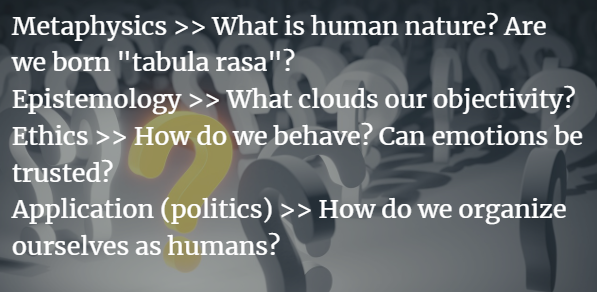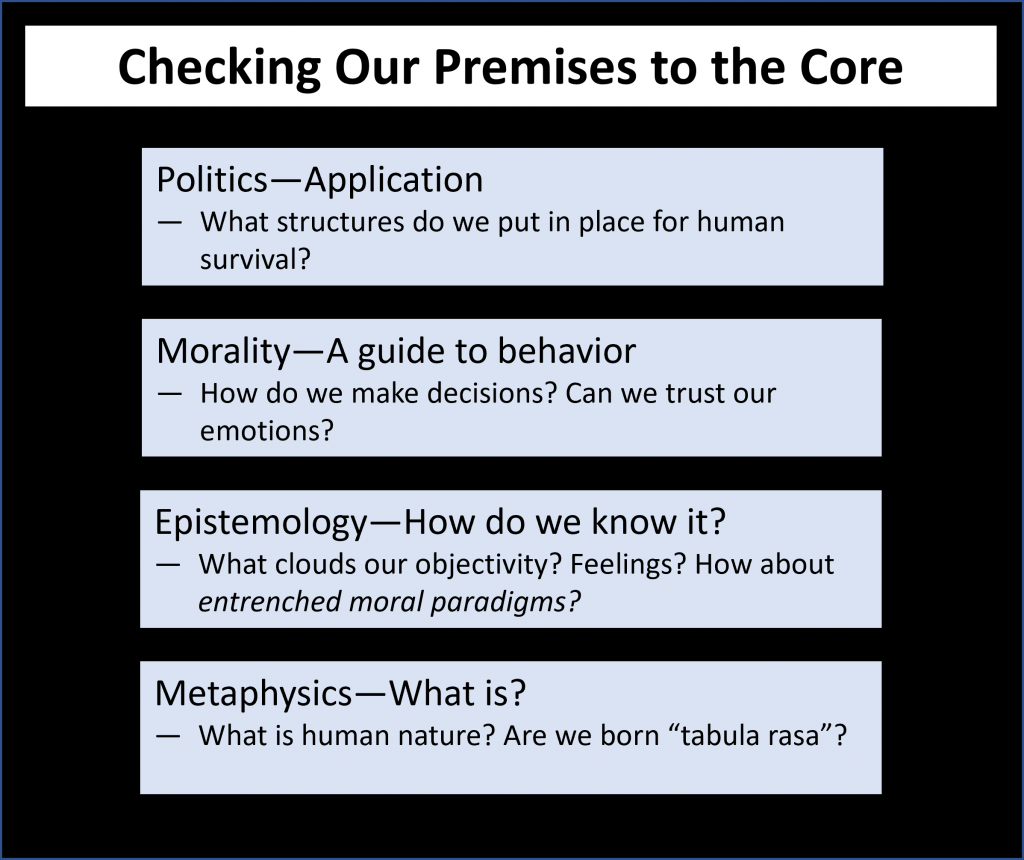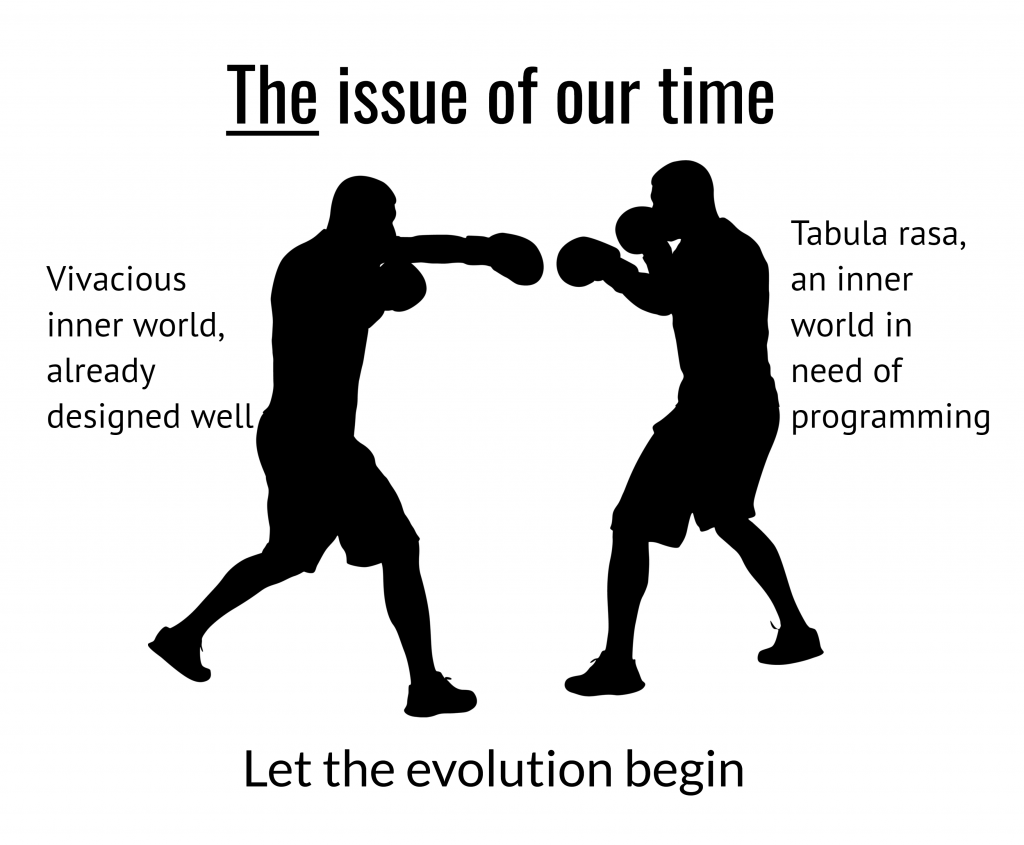
This is the structure to The Moral Bias of Objectivism: How Moral Ideals Cloud Objectivity. Read the start of the Preface starting at the main page of this site, ExObjectivist.com.
The Structure of The Moral Bias of Objectivism
This book is divided into four parts. In its counter arguments, it follows the structure of Rand’s Objectivism itself.
As any well-read Objectivist knows, Rand divides her philosophy into five parts. The foundation of her philosophy consists of two of those parts: metaphysics and epistemology. Metaphysics is the study of what is. Epistemology is the study of how we know it. The third part of Rand’s Objectivism is morality, a code of behavior. It is, as she argues, based on metaphysics, as it is based on the metaphysics (the unalterable nature) of who man is. Her morality dictates that man’s unalterable nature is a creature of reason and therefore living as a rational producer is the ethical ideal. The last two parts of Rand’s philosophical system are politics and art. These are based on the morality portion of her philosophy, because they are based on the vision of the ideal man, as put forth in her morality. Rand’s favored political paradigm, capitalism, is catered to her moral ideal of man the rational producer. Rationally superior art, in Rand’s Objectivism, projects the ideal of man, which is as rational producer, or confirms and validates this ideal for him.
My counter to Rand will follow this structure, except it will focus primarily on studying man’s inner world and how it operates.

My counter argument starts at the base of Rand’s philosophy, at the level of metaphysics and epistemology. Part I of this book is entitled “The ‘Is’: Metaphysics and Epistemology.” Like Rand’s Objectivism, it will focus on what is and how we know it. This book is about human nature itself, however, so Part I focuses on what human nature is and how we come to know it. It focuses mainly on the inner world: emotions, happiness, and the subconscious.
My primary (foundational) accusation against Rand is that she had a poor understanding of human nature itself. As such, Part I discuss matters related to this. I discuss the “is” of human nature: what Rand’s view of human nature was, what actual human nature is, what the nature of emotions are, etc. It’s the main issue of this entire book and of all moral paradigms: are natural emotions trustworthy or not? If emotions are inherently untrustworthy, we need an ethics to restrain them. If trustworthy, we do not.
I also discuss how we know what we know—again, as related to human nature. This can get truly discombobulated as we study our own species using our own reason, with all of its inherent biases. Although we are with ourselves every day, as Carl Jung writes, man remains a mystery to himself. I raise questions like: What is “reason”? Do we use it to study (as an observational force) -or- to make all decisions (as an active force)? Are mere feelings a threat to objectivity? Are they a threat to good decision making? What otherwise is a threat to objectivity? I give my answer to this last question: moral bias is a threat to objectivity.
Part I discusses the main issue in this book: if our inner world has some innate wisdom to it such that it can be trusted -or- if our inner world is inherently suspicious and must be programmed with a morality. This is the issue in this book. The latter position is the premise on which all of Objectivism (and all religion and current western science) rests. Challenging it will affect all of the other areas of its philosophy, to include its morality and politics.

This is also core to the main accusation in this book: that moral paradigms prevent objectivity. In this case, by trying to control it, Objectivism prevents us from getting curious about our inner world, and all the benefit that doing this would provide.
This thus gives rise to Part II of this book, which discusses how to then behave, given these two competing views of human nature. Can we trust the innate wisdom of our emotions in making decisions? Or should we be controlled by an all-encompassing ethical system? This would be the equivalent to the morality portion in Rand’s Objectivism. However, I reject an all-encompassing morality as such, and therefore I don’t call this section this. Instead, Part II is called, “How to Behave: Moral Paradigms versus Emotions.” As all moral paradigms try to directly control a person’s emotions, it is moral paradigms versus emotions. I will be describing that the wild human (what we are naturally born with) deserved a passionate moral defense—to be held up in honor—and, as such, I will be describing some of the good that (natural) emotions can play in life. It’s not my intention to describe this fully in this book (this would require volumes of work) but to give it some due, to show us what we are missing by trying to control this aspect of life with heavy-handed moralities.
I also discuss the utter havoc that moral paradigms do to one’s inner life and to the relationships one has with others. In this book, I call out Objectivism. However, I call for a rejection of any and all all-encompassing moral paradigms. They create shame, anxiety, unease, and deep envy. They also create for caustic, distant relationships with others. I have many quotes to show this, as pertaining to Objectivism, as well as my own personal experience, having lived as an Objectivist for ten years.
I also discuss in Part II the narcissistic and psychopathic tendencies of both Rand and her fictional characters. I discuss how much Objectivism, with its focus on “laser-like reason” and a suppression of natural emotions, follows along with how a narcissist thinks. This is as following the work of Sam Vaknin, who most agree, right or wrong on any other issue, is remarkable at describing the mind of a narcissist. The entire premise of Objectivism is that your natural self—your “true” self—is potentially bad and you need an overlay—a morality—put on top of it. This is just like a narcissist, who puts on a “false” self over their “true” self. Objectivist circles are filled with narcissistic abuse, gaslighting, and manipulation for a reason. It’s not random that this happens.
“But I don’t think of you.”—Howard Roark
Objectivism, like all moral paradigms, ultimately lends itself to abuse. I will give my own experiences with this, and I will give well-documented cases of historical Objectivist abuse. Being able to control people’s emotions, which is exactly what Objectivism attempts to do, is a hunting ground for abusers. If you can control this—a person’s emotional mechanism—you can control all sorts of things about a person. You now have power over what “should” make a person happy, if they are allowed to be angry, if they can be “negative,” who they should regard as a hero, who is rational, who is irrational, and much more. Religion has long perfected this art of gaslighting people about their entire inner world; Rand just updated it with a more modern, secular flair. The issue here is whether or not people can have their own emotions -or- if their emotions have to be “programmed” (Rand’s word) to have a “better,” more “rational” inner core. And I don’t think there can be any other issue more important or more fundamental to human existence. I’m asking you to pay attention.
Finally, in Part II, I conclude that morality itself cannot inspire fruitful, positive action. It, instead, can only prohibit certain unideal actions. Morality itself cannot do what it promises it can do: it cannot inspire heroics and it cannot command positive (proactive) ethical behavior. Morality itself, as such, can only inhibit us, when and where we think it’s ideal to inhibit natural human behavior. That’s it. That’s all it can do. As far as successfully living life, I call for us to turn away from using a moral system to guide life and to move towards science, or, rather, more specifically, to the natural observation of the world, in this case, as applied to human nature itself. I also call for emotional intelligence tools to replace what moral paradigms attempt to do. They serve as far superior solutions to deal with the original problem that all moral paradigms purport to solve but cannot: that emotions can sometimes be destructive.
Part III then discusses the practical applications of these two competing world views. It is, as such, the technology of applying a new, better science to matters relating to human nature. It would be equivalent to the “politics” portion of Objectivism, but I want to get away from this idea that politics itself (government) guides or shapes most, or any, of human life. This section is, as such, named, “The Application: Designing a World around the Wild Human.” And, no, I won’t apologize for the seemingly paradoxical nature of this phrasing, because I love it—and I mean it. This section discusses how this alternative, competing view on human nature (that natural emotions have validity) would change the way childcare, medicine, relationships, and more are approached.
To make the understatement of all understatements, if we valued the wild human, we’d be free. This vivacious inner force, teeming with emotions, that I am describing—the wild human—demands to be free. This is the issue of our time. When science meets the wild human, it’s game over for tyranny. And by “science” I mean “the natural observation of the world,” not that garbage currently being used, which seeks to cut, hack, inject, and mangle humans in the name of health. When we have a conscious, deliberate respect for the wild human, such that we study it and hold it up in honor, we will have a free, thriving species. I think, in our Post-Industrial world, this is what people have been longing for but haven’t quite fully imagined yet. It’s nothing like we’ve ever seen before: it’s civilization meets the wild. But, as human nature works, when you can imagine it, you can realize it.
If we valued the true vivacious force within, all of our staple institutions would be different. We’d undoubtedly have more respect for the natural development of children. Our relationships would be more egalitarian. We’d have far more, open, freer, raunchier sex. Whether or not we trust the innate wisdom of our body or we believe our rational mind should control and fix it has profound implications in medicine.
And, with a respect for the wild human, government can do nothing but scale back. Far more behavior would be tolerated than is now. It would definitely mean an end to the drug war, as one example. It would also mean an end to the endless rules put on us, as is done now through insidious alphabet soup government agencies, as is done in every totalitarian society (read: America as is now). These are all “rational” measures, meant to keep us “safe,” of course. This is how all dictatorship works. Oh, they let you be free…if. And that’s Rand’s exact position on government: you are allowed to be free…if. No, freedom is absolute and uncompromising. No top-down government can fix any problem that humans face. Free humans can always solve their own problems.
Rand promises people happiness and freedom with her philosophy. But, in truth, all of her favored systems are highly authoritarian in nature. The favored educational approach in Objectivism, as I will outline in detail, is highly traditional and authoritarian. Sex is a judgment against your moral character. Men are considered superior to women. And, no, Rand actually explicitly did not grant you gun rights to defend yourself. She explicitly writes that you must delegate your physical self-defense—the enactment of it—to the government. And, no she did she grant full, unbridled freedom, either. She said, if given a rational reason (and aren’t they all?), government control is warranted. As such, she grants that one little crack, that one little thing that has always let government tyranny in: Authorized Emergency Powers.
You know, it’s almost as if Rand pacified her followers, promising peace and freedom, all while letting government do what it’s always done: promise people freedom, while scaring them about everything under the sun, such that the powerful can grab yet more power. And let it be noted that every moral paradigm purports to be for “true” freedom. All. Of. Them.
So, Part I, II, and III of this book follow congruent to Objectivism itself. In Part IV, the final section, I expand it further, into the future and into the new. I discuss how to stand up to abusive moral paradigms, such as to move society forward. I discuss how abuse is, always, couched inside a person’s moral paradigm. Abuse is not “unconscious.” People are very deliberate about what punishment, war, or totalitarianism they want to inflict on their fellow man. They feel profoundly morally justified. We think abuse is some dark, evil character that strikes in the night. In truth, it’s out in broad daylight, and the majority find it totally ethical. In Part IV, I discuss how to stand up to these abusive moral paradigms, to shift the world more towards one of authentic respect, towards ourselves and towards each other. I call this section “Ending Abuse: The Heroes We Need.” It’s what a truly moral moral paradigm would do. It’s what heroism can do when put towards a worthy cause and when fueled by emotional intelligence.
Heroism fueled by emotional intelligence. It’s almost as if it’s what is possible when the masculine and the feminine meet. Indeed, this book is an anthem to the wild feminine—a natural force that is healing in how it is both nurturing and cruel. It is a force that would do its thing if it weren’t, as Rand writes in Atlas Shrugged is the most feminine look of all, chained. This book can be considered an utter battle cry against all patriarchal paradigms, of which Objectivism undoubtedly is.
By the way, Objectivists, what percentage of women are in your ranks? It keeps dwindling, doesn’t it? Think this isn’t a “valid argument”? It is the most valid argument possible. It is Femininity—Shrugged.
Finally, in the Epilogue, I summarize some of my challenges. I also discuss why it will still be so hard to penetrate the entrenched Objectivist mind. Certain, specific tactics are used to enmesh a person to a moral system, resulting in the phenomenon I describe in this book: moral bias.
Jump to >> What’s in this challenge for you?
Leave a comment